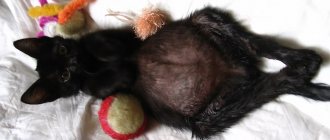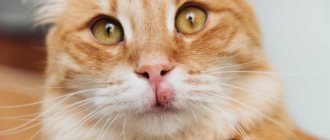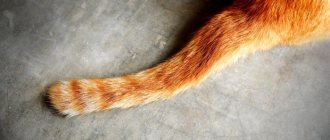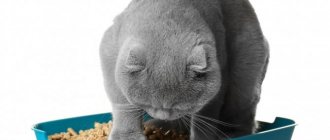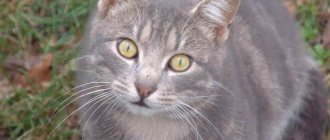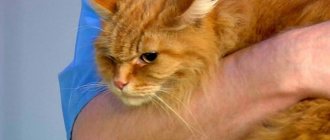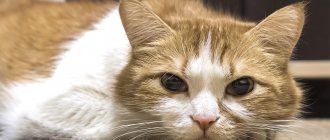4142Pavel
In most cats and cats, bilateral inflammation develops, which is not localized, but covers the entire thoracic region. Lack of timely monitoring can lead to death. With pleurisy, the pulmonary region and heart are at risk, and these are vital systems of the pet’s body.
In case of illness, the pleural surface is filled with moisture. In a normal healthy state, the pleura in the chest also releases moisture, but this amount is enough for “basic” processes to occur. When the fluid volume is exceeded, the pressure on the organs increases. If treatment is not organized, pathologies with the lungs and heart cannot be avoided.
© shutterstock
What it is?
The pleura is the thinnest serous membrane that lines the inside of the chest. Accordingly, “pleurisy” is its inflammation. Pleurisy can be dry, but more often its exudative variety develops, characterized by the release of a large volume of effusion exudate. Accordingly, the disease can be divided into varieties depending on its type: serous, purulent. Pleurisy in cats in most cases takes a generalized form, completely covering the pleural surface of the entire chest. This is bilateral pleurisy. In cats, cases of unilateral development of this disease are extremely rare.
There is no need to think for a long time about the danger of the process: the very fact that there may well be a heart in the immediate vicinity of the source of inflammation is enough to begin emergency treatment measures.
The accumulation of fluid in the chest, which is otherwise called pleural effusion (exudative type of disease), is very dangerous. In its normal state, the pleura also secretes a small amount of moisture, which serves as a lubricant to ensure normal glide of the lungs along it. When, as a result of inflammation, a large amount of exudate or transudate is released, the fluid begins to compress all the organs of the chest. It is important to emphasize that pulmonary edema has no direct relation to this pathology.
Pleurisy in a cat
Pleuritis is an inflammation of the costal and pulmonary pleura in a cat.
Anatomical data.
Pleura (from the Greek pleurá - rib, side, wall), a serous membrane lining the inner surface of the chest and the outer surface of the lungs. Forms two symmetrical isolated bags located in both halves of the chest; between them the space is the mediastinum (mediastinus). Each pleural sac has a slit-like pleural cavity.
The pleura consists of two layers: parietal (parietal, or parietal pleura) and visceral (visceral pleura). The parietal pleura lines the inner surface of the chest, the visceral pleura covers almost the entire surface of the lungs. The pleura in animals forms symmetrical right and left sacs, the space between which is called the mediastinum. In the mediastinum in animals there are the trachea, esophagus, heart, large blood vessels, lymph nodes, and nerves. Between the visceral and parietal pleura there is a slit-like microscopic cavity, which contains a small amount of serous fluid. This liquid is intended to reduce the friction force of the pleura during the work of the lungs when the animal breathes. In addition, in each pleural layer there are microscopic slit-like openings into the mediastinum. With inflammation of the pleura, this contributes to the rapid transition of the inflammatory process from the pleura to the lungs and vice versa.
The pleura is supplied with blood from the intercostal and internal thoracic arteries, and the visceral pleura is also supplied from the diaphragmatic vessels.
Pleurisy in its origin is primary and secondary. Primary pleurisy is a lesion of the pleura when the inflammatory process initially began to develop in the pleura itself.
Secondary pleurisy is when pleurisy in an animal occurs as a result of complications from diseases of neighboring organs (pneumonia, bronchitis, cancer, etc.).
According to its course, pleurisy in cats can be acute, subacute and chronic. Acute pleurisy in a cat lasts up to 14 days, subacute up to 60 days, chronic lasts several months and even several years.
Pleurisy in its localization can be unilateral or bilateral.
Depending on the nature of the inflammation, dry (Pleuritis sicca) and exudative (Pleuritis exsudativa) are distinguished; with dry pleurisy, the exudate is layered on the pleural layers, which thicken and become rough (fibrin).
According to the nature of the exudate, pleurisy can be serous, serous-fibrinous, purulent, purulent-putrefactive, hemorrhagic and ichorous. With purulent-putrefactive pleurisy, as a result of decomposition of the exudate, accumulation of liquid and gases in the pleural cavity (hydropneumothorax) can occur.
Etiology. Pleurisy in a cat can occur:
- During the transition of the inflammatory process with a number of located organs (pneumonia).
- Infectious diseases (when pathogens - viruses, bacteria through the blood and lymph flow enter the pleural cavity).
- For oncological diseases of the thoracic cavity (lungs, esophagus, mediastinal lymph nodes).
- Traumatic injuries to the chest (cat falling from a great height).
- Diseases of the abdominal organs - pancreatitis (pancreatitis in cats), renal failure, etc.
- A certain seasonality has been noted, i.e. In spring and autumn, in rainy weather, inflammation of the pleura is more common, especially in urban conditions, in pampered cats.
Pathogenesis. Pleurisy in a cat develops in three stages: hyperemia, exudation and resolution.
The microflora, having entered the pleura through the lymphatic, blood vessels or by extension, begins to multiply intensively, causing the development of the inflammatory process.
The initial stage of pleurisy development is characterized by the exudation of fibrinous exudate. When the cat’s body is highly resistant, a protective barrier is formed around the inflammatory area, and in this case the cat develops focal fibrinous pleurisy. If the inflammatory process develops intensively, then the unaffected areas of the pleura are not able to absorb the excess exudate formed. The animal develops serous or serous-fibrinous pleurisy. When purulent and putrefactive microflora enter the pleural cavity, the exudate becomes purulent-putrefactive, and when red blood cells sweat, it becomes hemorrhagic.
During the accumulation of fluid in the pleural cavity, compression of the lungs occurs, negative pressure in the chest decreases, the flow of venous blood to the heart and its entry into the systemic circulation decreases, pressure in the veins increases and decreases in the arteries, and the excitability of the receptors is dulled. As a result of all this, oxygen starvation increases in the body of a sick animal, intermediate decay products accumulate, and the colloidal system of the blood changes. This leads to loss of chlorine in the blood, the occurrence of albuminuria, disruption of the nutrition of many tissues, especially the heart muscle, and stimulation of the vomiting center. Impaired tissue nutrition negatively affects the functions of the brain, heart muscle and smooth muscles of the gastrointestinal tract.
Microbial toxins and inflammatory products, absorbed into the blood, upset the thermoregulation center and cause a sharp increase in body temperature in the cat. The inflamed pleura is very sensitive, and when the affected leaves are rubbed during breathing, the cat experiences severe pain. Irritation of nerve receptors causes coughing.
In chronic pleurisy, fibrinous exudate may grow into granulation tissue or fibrinous tissue may grow on the inflamed wall of the pleura. Sometimes fusion of the layers of the pleura occurs - adhesive pleurisy.
Pathological and anatomical changes. With dry (fibrinous) pleurisy, changes manifest themselves in the form of hyperemia, the pleura is dull, and there are layers of fibrin on the pleura.
With wet (serous, serous-fibrinous, purulent) pleurisy, simultaneously with fibrinous exudate, we find a large amount of fluid in the pleural cavity.
The chronic form is characterized by the presence of adhesions between the pleura, lungs and heart.
Clinical picture. The general condition of the sick animal is depressed; the cat's owners note a decrease or refusal of food. Body temperature rises by 1-2 degrees. The pulse is frequent and weak. Breathing at the beginning of pleurisy is superficial, rapid, and later, as exudate accumulates, it becomes less frequent, but deeper. The cough is weak, but frequent and painful. On palpation and percussion in the intercostal space we note severe pain. During auscultation of the lungs at the beginning of the disease, we hear intermittent pleural friction sounds. When exudative pleurisy develops on the affected half of the pleura, respiratory sounds disappear, while on the healthy half there is increased vesicular breathing. With exudative pleurisy, the veterinarian notes shortness of breath with difficulty breathing. With adhesive pleurisy, a cat exhibits abdominal breathing. If exudative pleurisy with a large amount of fluid is one-sided, breathing becomes asymmetrical, the cat takes a sitting position with an elongated head to facilitate breathing.
The cat's urine becomes brown with a foul odor, and the feces are dry.
Diagnosis. The diagnosis of pleurisy is made by a veterinary specialist at the clinic based on the collected medical history of the animal owner, clinical symptoms of the disease, and data from a general blood test (neutrophilic leukocytosis). In case of pleurisy, a sick animal undergoes an X-ray diagnosis of the chest organs or an ultrasound scan. An x-ray shows the presence of pathological fluid in the pleural cavity.
In order to determine the nature of the exudate in the pleural cavity, thoracentesis is performed (puncture of the chest in the area where the pleural cavity is located).
Differential diagnosis. When diagnosing pleurisy, veterinary specialists rule out hydrothorax pneumonia (pneumonia in a cat) in a cat.
Treatment. When treating pleurisy, the clinic’s veterinary specialists first of all eliminate the cause that caused the pleurisy. Treatment of pleurisy is complex. A course of antibiotics, sulfonamides, analgesics, diuretics, multivitamins, and other medications is prescribed based on the concomitant diseases the cat has. A heating pad, bags of warm river sand are applied to the chest, and irritants are also rubbed in. In the case when a cat has purulent or putrefactive pleurisy, veterinary clinic specialists perform thoracentesis to remove the exudate accumulated in the pleural cavity, followed by washing the pleural cavity with antiseptic solutions. As with other diseases, the cat is provided with a balanced diet.
Forecast. The prognosis for pleurisy in a cat depends on how promptly the owners of the animal contacted the veterinary clinic. With timely treatment, complete recovery of the animal is possible in 2-3 weeks. In case of chronic pleurisy, the disease must be treated for 1-2 years.
Prevention. Prevention of pleurisy in a cat is based on the prevention and timely treatment of diseases and traumatic injuries that can lead to the occurrence of pleurisy. Pet owners should not allow their cat to become hypothermic.
What causes pleurisy?
The causes of this pathology are very diverse. Here is their main list:
- Increased hydrostatic pressure due to congestive heart failure (CHF), overhydration, or tumors in the chest cavity.
- Hypoalbuminemia (low levels of protein in the blood), which results in many liver or intestinal diseases.
- Changes in the permeability of blood vessels (i.e. they become “leaky”). This often happens with generalized forms of allergic reactions.
- Obstruction of large lymphatic ducts. When the pressure in them goes off scale, fluid begins to leak en masse into the chest cavity.
- Chylothorax. A pathological condition involving rupture of the thoracic lymphatic duct. As a result, inflammation develops and, accordingly, pleurisy of the lungs in cats.
- Diaphragmatic hernia.
- Hemothorax, that is, blood entering the chest cavity.
- Injuries accompanied by a violation of the tightness of the chest.
- Pulmonary thromboembolism (blood clot in the lungs).
- Pneumonia: viral, bacterial or “fungal” pleurisy, depending on the etiology of the process.
- Cancer (especially lymphosarcoma (LSA), thymoma, mesothelioma). A common complication of these diseases is metastatic pleurisy in cats.
- Pancreatitis, oddly enough. There is a clear relationship between cases of acute pancreatitis and purulent pleurisy.
Why does pleurisy appear?
Among the causes of disease in cats, a number of factors stand out::
- Heart failure and subsequent tumor. The appearance of a tumor increases pressure, which negatively affects the condition of the pleura and becomes the cause of pathology.
- Low protein levels. A small amount of the protein component is a consequence of diseases of the intestines and stomach. This can also lead to pleurisy.
- Violation of vascular permeability. When blood vessels lose their tightness, the level of moisture in the chest increases. This happens mainly due to allergies and other congenital ailments.
- Disturbances in the lymphatic ducts. A sharp increase in pressure stimulates intense penetration of fluid into the chest, which directly affects the cat’s condition.
- Chylotrax and diaphragmatic hernia. These are pathologies, after which (without timely treatment) the inflammatory process rapidly develops.
Another cause of pleurisy is hemotrax or blood entering the chest area. This may also be due to the formation of a blood clot in the lungs.
Pleurisy refers to a number of symptoms:
- Difficulty breathing. The cat begins to breathe heavily and sharply. Moreover, the pet breathes intermittently, with varying intensity. This indicates a severe form of the disease.
- Sitting position with head extended. If there is an illness for a cat, this is the only position in which the pet can breathe. If the animal remains in this position for too long, the alarm should be sounded.
- Blue discoloration of the mucous membrane. This is cyanosis - a process in which all mucous membranes on the cat’s body that are visible to the owner begin to take on a bluish tint. This is due to increased pressure on internal organs.
- Mouth breathing. When a cat's condition reaches a critical level, the pet cannot breathe through its nose. The cat begins to make characteristic sounds with its mouth.
- Loss of appetite and apathy. The cat feels a deterioration in its condition and senses a danger to its life. Apathy and panic, subsequent lethargy indicate that you urgently need to consult a specialist.
Symptoms of serous pleurisy vary from person to person, but there are also general signs. This is an unusually wide open mouth and too rapid breathing, which makes you pay attention to the cat. A veterinary examination is the only way to determine the exact cause of health problems.
© shutterstock
Symptoms
What are the symptoms of this disease? Let us list the most typical ones, allowing us to more or less accurately make at least a preliminary diagnosis:
- Difficulty, or sharply rapid, shallow breathing.
- The cat takes a sitting position and stretches its head up. A very specific symptom, indicating the accumulation of a large amount of exudate. It is important to remember that in a different position the animal simply cannot breathe.
- Cyanosis (blue discoloration of all visible mucous membranes).
- The cat begins to breathe through its mouth.
- Loss of appetite.
- Lethargy, apathetic state.
For many cats, the most characteristic symptom is a wide open mouth, rapid and very shallow breathing. As a rule, it is easier for them to inhale (when exhaling, a strong pain reaction is noted). The development of “abdominal” breathing is also very characteristic.
Symptoms of pleurisy in animals
Signs of the inflammatory process developing in the pleura in cats depend directly on the stage, location and form of the process. Characteristic signs of inflammation of the serous membrane are:
- disturbance of the animal’s breathing rhythm (the cat makes superficial movements when breathing through the chest);
- apathy and lethargy of the pet;
- a sharp decrease in appetite;
- asymmetrical type of breathing (the side of the chest where the inflammatory process occurs lags behind the healthy one when breathing);
- noise in the sternum when breathing.
The painful sensations experienced by the cat when breathing make it meow pitifully and ask for help. With a strong exudation of pus, the pet’s general condition worsens - the visible mucous membranes acquire a bluish tint, blood pressure levels decrease, and the urine becomes dark with a repulsive, pungent odor.
One of the characteristic signs of bilateral pleurisy is the forced posture of the pet. The cat sits and stretches its head unnaturally forward, trying to take a full breath. The prognosis for the development of inflammation in the serosa of the chest is always cautious, and sometimes unfavorable. This depends on the speed of treatment started, the body’s own strengths and the reasons that caused the pathology.
When do metastases appear?
In the presence of a malignant process in the body of a domestic cat, as a rule, the tumor metastasizes to other organs and tissues. For example, mammary cancer, which is common in cats, metastasizes to the pleura. The developing tumor compresses the lymphatic and blood vessels, leading to disruption of transudate effusion into the chest cavity.
X-ray of a cat: metastases in the lungs, hydrothorax
In addition, toxins produced by cancer cells lead to increased permeability of capillaries and lymphatic vessels, which increases the amount of serous fluid in the chest.
The development of hydrothorax with an oncological diagnosis in a pet is a sign of an unfavorable prognosis due to the involvement of other organs and systems in the pathological process.
